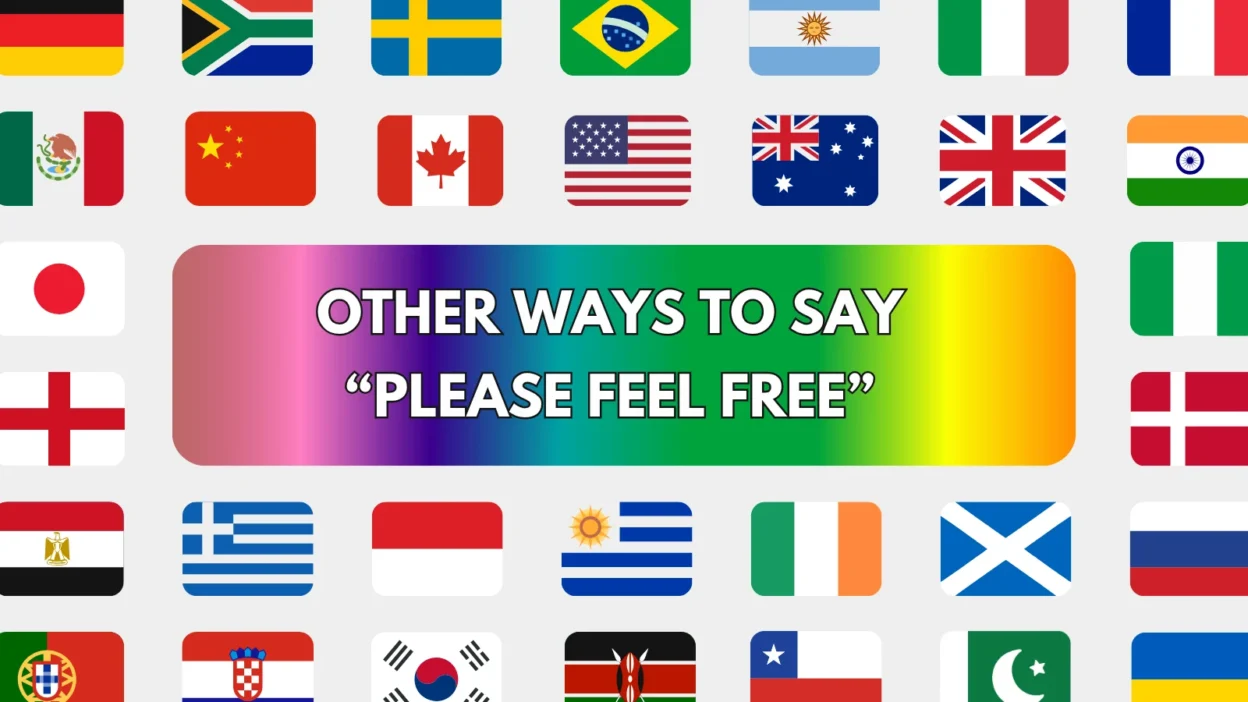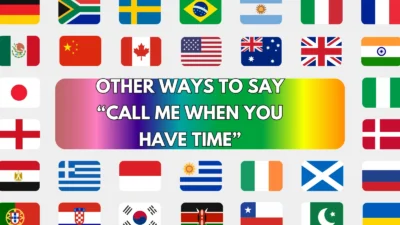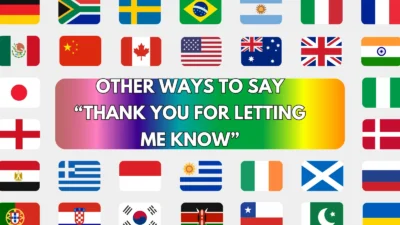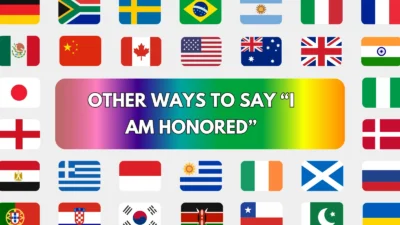The phrase “please feel free” is often used to encourage someone to take action without hesitation — whether it’s asking questions, sharing opinions, or contacting you anytime. It’s polite and open, but there are many other ways to say it that sound more natural, friendly, or professional depending on the situation.
This article offers 25 effective alternatives to “please feel free,” with meanings, explanations, examples, and tones to help you express the same idea in different ways.
1. Don’t hesitate to
Meaning: Encourages someone to take action confidently.
Detailed Explanation: A polite and professional alternative often used in writing or business communication.
Scenario Example: Don’t hesitate to reach out if you have any questions.
Best Use: Professional emails, customer service.
Tone: Courteous, professional.
2. You’re welcome to
Meaning: Gives someone permission or comfort to do something.
Detailed Explanation: Sounds warm and inviting, perfect for both formal and casual situations.
Scenario Example: You’re welcome to join us for the meeting anytime.
Best Use: Invitations, teamwork.
Tone: Friendly, polite.
3. You can always
Meaning: Suggests ongoing permission or availability.
Detailed Explanation: Works well when reassuring someone they can reach out whenever needed.
Scenario Example: You can always message me if you need help.
Best Use: Friendly or professional reassurance.
Tone: Supportive, kind.
4. Don’t be shy about
Meaning: Encourages someone to act confidently.
Detailed Explanation: Adds a friendly and relaxed tone to the invitation.
Scenario Example: Don’t be shy about asking if you need any clarification.
Best Use: Informal conversations, mentorship.
Tone: Warm, encouraging.
5. You’re free to
Meaning: Gives permission in a clear and polite way.
Detailed Explanation: Simple and straightforward for formal writing or conversation.
Scenario Example: You’re free to use these resources for your presentation.
Best Use: Workplace, instructions.
Tone: Neutral, polite.
6. Go ahead and
Meaning: Gives encouragement to proceed confidently.
Detailed Explanation: Friendly and conversational; great for casual settings.
Scenario Example: Go ahead and email me if you need the document.
Best Use: Informal communication.
Tone: Relaxed, friendly.
7. You’re more than welcome to
Meaning: Adds warmth and enthusiasm to your permission.
Detailed Explanation: A kind way to make someone feel appreciated for taking action.
Scenario Example: You’re more than welcome to stop by anytime.
Best Use: Hospitality, personal or business invites.
Tone: Warm, generous.
8. Don’t think twice about
Meaning: Reassures someone that they’re not bothering you.
Detailed Explanation: Works well when you want to sound approachable and sincere.
Scenario Example: Don’t think twice about reaching out if something comes up.
Best Use: Friendly, supportive tone.
Tone: Reassuring, genuine.
9. You can reach out anytime
Meaning: Lets someone know you’re available whenever needed.
Detailed Explanation: Combines professionalism with friendliness.
Scenario Example: You can reach out anytime if you need assistance.
Best Use: Emails, professional communication.
Tone: Supportive, professional.
10. Feel welcome to
Meaning: Invites someone politely to do something.
Detailed Explanation: Softer and more personal than “please feel free.”
Scenario Example: Feel welcome to share your ideas during the meeting.
Best Use: Work, teamwork, collaboration.
Tone: Kind, polite.
11. Don’t hold back
Meaning: Encourages openness or honesty.
Detailed Explanation: Perfect when you want people to speak freely or give feedback.
Scenario Example: Don’t hold back — we value your input.
Best Use: Group discussions, brainstorming.
Tone: Motivating, open.
12. I encourage you to
Meaning: Politely invites or supports someone to act.
Detailed Explanation: Adds a positive and supportive tone.
Scenario Example: I encourage you to reach out if you have more questions.
Best Use: Guidance, mentorship.
Tone: Supportive, positive.
13. You’re invited to
Meaning: Formal yet friendly invitation.
Detailed Explanation: Often used for meetings, discussions, or events.
Scenario Example: You’re invited to share your feedback after the session.
Best Use: Professional, event communication.
Tone: Polite, formal.
14. It’s absolutely fine to
Meaning: Gives reassurance and permission together.
Detailed Explanation: Helps people feel comfortable taking action.
Scenario Example: It’s absolutely fine to contact me outside office hours if urgent.
Best Use: Customer service, work environments.
Tone: Reassuring, calm.
15. Don’t worry about
Meaning: Removes hesitation or concern.
Detailed Explanation: Works when someone might feel unsure or nervous.
Scenario Example: Don’t worry about asking — I’m happy to help.
Best Use: Friendly reassurance.
Tone: Relaxed, comforting.
16. You can go right ahead
Meaning: Confirms that someone has permission to continue.
Detailed Explanation: Simple, direct, and encouraging.
Scenario Example: You can go right ahead and upload your file now.
Best Use: Instructional, professional.
Tone: Clear, polite.
17. Please don’t hesitate to ask
Meaning: Standard polite phrase in formal communication.
Detailed Explanation: Very common in customer service or professional writing.
Scenario Example: Please don’t hesitate to ask if you need further clarification.
Best Use: Business emails, support messages.
Tone: Formal, polite.
18. You’re encouraged to
Meaning: Shows openness and motivation for participation.
Detailed Explanation: Ideal for teamwork, learning, or group settings.
Scenario Example: You’re encouraged to share your ideas during the workshop.
Best Use: Educational or professional contexts.
Tone: Positive, motivational.
19. You have my permission to
Meaning: Clearly grants approval in a formal tone.
Detailed Explanation: Suitable for official or authoritative communication.
Scenario Example: You have my permission to proceed with the proposal.
Best Use: Business or management settings.
Tone: Formal, clear.
20. I welcome you to
Meaning: Invites someone warmly to act or participate.
Detailed Explanation: Combines friendliness with politeness.
Scenario Example: I welcome you to share your opinions anytime.
Best Use: Collaborative or friendly situations.
Tone: Warm, polite.
21. Go for it
Meaning: Casual encouragement to take action.
Detailed Explanation: Common in friendly conversations when motivating someone.
Scenario Example: You want to give it a try? Go for it!
Best Use: Informal chats, motivation.
Tone: Energetic, fun.
22. You’re allowed to
Meaning: Formally grants permission.
Detailed Explanation: Often used in instructional or workplace contexts.
Scenario Example: You’re allowed to access these documents for your research.
Best Use: Rules, permissions, guidelines.
Tone: Neutral, formal.
23. Please go ahead
Meaning: Politely allows someone to proceed.
Detailed Explanation: Common in professional or courteous exchanges.
Scenario Example: Please go ahead and start the presentation.
Best Use: Meetings, workplace, service interactions.
Tone: Polite, professional.
24. It would be great if you
Meaning: Softly encourages someone to act.
Detailed Explanation: Invites action without pressure.
Scenario Example: It would be great if you could share your feedback soon.
Best Use: Polite requests, teamwork.
Tone: Courteous, professional.
25. I’m open to
Meaning: Expresses willingness or receptiveness.
Detailed Explanation: Useful for collaboration, discussion, or feedback.
Scenario Example: I’m open to any suggestions you might have.
Best Use: Business, teamwork, communication.
Tone: Collaborative, polite.
Conclusion
“Please feel free” is a kind and open phrase, but it can sound repetitive when used often. These 25 alternatives help you tailor your tone — from professional and polished to casual and friendly — depending on your situation.
Whether you say “Don’t hesitate to ask,” “You’re more than welcome to,” or “Go for it,” the goal remains the same: to invite openness, comfort, and confidence in your communication.




